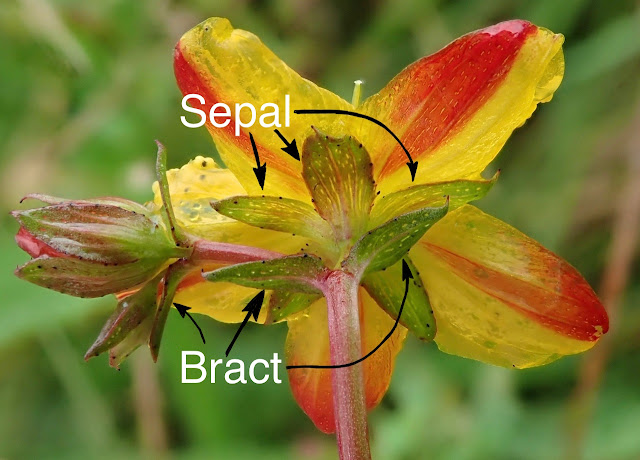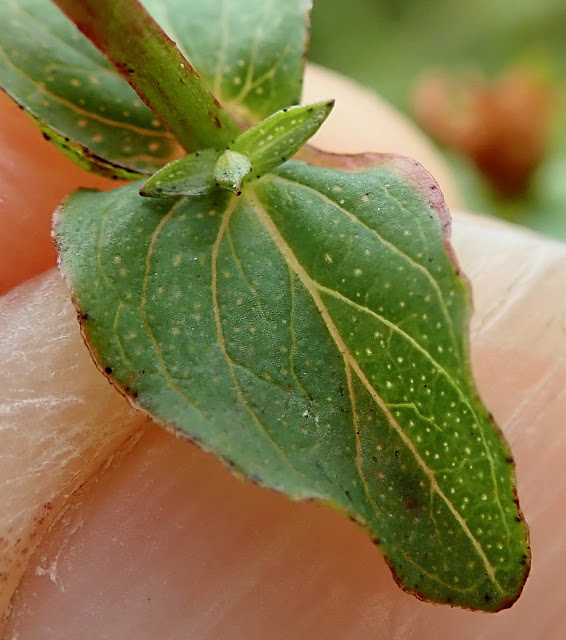Rosa agrestis Small-leaved Rose in Cambridgeshire.
In June 2020 Joe Sharman (of Monksilver Nursery at Cottenham) brought Alan Leslie ( author of Flora of Cambridgeshire) a specimen of an unusual rose he had collected from near Knapwell Wood. Alan recognised it as a probable R. agrestis and this was confirmed by a visit to the site and subsequent confirmation by the BSBI rose expert Roger Maskew. This was the first record for Cambridgeshire. I had been attempting to take photos of all the wild roses found in Cambridgeshire, so this proved an added bonus as this was not a species I had considered as a remote possibility. There is only one other dot on the BSBI map in East Anglia and that is near Norwich.
R. agrestis is a very rare rose with just a scattering of records in Southern Britain and slightly more in the centre of Ireland.
This blog contains some photographs of the excellent find by Joe and Alan.
R. agrestis belongs in the Section Caninae because it has the peculiar canina meiosis where four fifths of the inheritable characteristics come from the seed parent. All roses in the section caninae are all unbalanced polyploids. R. agrestis is in sub-section Rubigineae with R. micrantha and R. rubiginosa.
 |
| R. agrestis Knapwell Wood, 15th June 2020 |
At first sight the flower could be passed over as just another Dog Rose.
 |
| R. agrestis. |
The stigma cluster is quite large nearly covering the disc and with few hairs if any. The disc is slightly convex. Again this could be within the variation of a Dog Rose R.canina.
 |
| R. agrestis, 15th June 2020 Sepals and pedicel. |
The pedicel (stalk just below the flower and hypanthium) has no glandular hairs being clean, again just like a Dog Rose
R. canina. The sepals have an upper surface covered in cobwebby hairs which is a feature shared with many other roses. The sepals are long and pinnate with edges showing the red tips of the glandular hairs. Sepals are reflexed at flowering stage. Again there is nothing here to separate it from a Dog Rose
R. canina although
the number of red tipped glandular very stalked hairs on the sepals is a bit unusual for a
R. canina.
 |
| R. agrestis Underside of leaf. 15th June 2020 |
Leaflet shape has narrow base (cuneate) which is not normal in Dog Rose and the stem between the leaflets ( petiole and rachis) are covered in stalked glandular hairs and no simple hairs. Hard to see in this photo but the leaflets have scattered clear glands all over the lower surface. Time to take a more detailed look as these glands are not consistent with a Dog Rose. |
| R. agrestis Underside of leaflet. 15thJune2020 |
The underside of the leaflet is covered with clear stalked glandular hairs and although there is some variation in the size of these glandular tips they are in the range 0.1-0.12 mm diameter for the larger, which is similar to those seen on R. rubiginosa and R. micrantha. |
| R. agrestis 22nd Aug 2020, Leaf upper-side somewhat shiny. The lower leaflets are often smaller and reflexed. |
 |
| R. agrestis Leaf upper side, new growth May 2021 |
 |
| R. agrestis Leaflet edge showing glandular edge. 22th Aug 2020 |
A close view of the leaflet edge shows a uniserrate edge with glandular hairs on both sides of the teeth which give it a multi-serrate look. The teeth tips have red hydathodes which are different to the glandular hairs in that they are solid and hard and pointed, not rounded. The glandular hairs are not really forming on distinct secondary-tips. Exact shape of leaflet edge does change depending on what part of the leaflet you look at and sometimes the glandular hairs do sit on secondary tips, as shown below on a new leaflet taken in May 2021.
 |
| New growth, May 2021. Multiserrate edge. |
 |
| R. agrestis Stipule at base of leaf. 15th Jun 2020 |
Stipule is quite narrow with stalked glandular hairs on the edge and also some on lower surface. The glandular hairs on the leaf stem (petiole) are often on a short stalk and the rachis and petiole lack any white simple hairs.
 |
| R. agrestis 15th Jun 2020. Stipule and young prickles. |
 |
| R agrestis. 15th Jun 2020 Base of terminal leaflet. |
Not all leaflets will be as extreme as this example but the narrow cuneate base is a key feature of
R. agrestis. Note also the stalked glandular hairs on the rachis with no simple white hairs.
A new word to learn....
 |
| R. agrestis. 15th Jun 2020. Leaflet veins highlighted to show semi-craspedodromus pattern. |
One of the important features in separating roses in the fossil record is the semi-craspedodromus pattern shown in some roses species. This is not a term I had come across before, so had to look it up.
Although quite subtle and not present in every part of the leaflets, overall these leaflets show this semi-craspedodromus pattern with the loops before the veins make it to the leaflet edges. In a craspedodromus leaf the veins all end up going directly to the leaf margin. Some may split on the way. The semi-craspedodromus venation is present in all the section caninae roses and many others, so it is not a useful ID feature but it would be an interesting find if you found a rose that did not have his feature. An example would be Rosa stellata which has leaves like a gooseberry, but it is not hardy in the UK coming from the deserts of Texas to Arizona.
 |
| Craspedodromus leaf venation Semi-craspedodromus leaf venation |
 |
| R.agrestis 15th Jun 2020. Stem prickle. |
The BSBI Rose handbook No7 shows the prickles having a very stout base whereas the prickles photographed were a more ordinary shape. However the shape of prickles is quite variable depending on what part of the stem you look at. These prickles are not very hooked.  |
| R. agrestis 15th Jun 2020 Near Knapwell Wood, Cambridgeshire. |
Finally a photo of the largest, possibly the original, plant in this group of about ten plants.
All these section Caninae roses are species derived from hybrids from their past evolution which continue to hybridise now. To identify a rare rose like R. agrestis, I am very grateful that Alan Leslie took a sample and sent it to BSBI rose expert Roger Maskew to be confirmed.
Peter Leonard
Rampton, Cambridgeshire.
6th May 2021
Ref:-
G. G. Graham and A.L. Primavesi.(1993) Roses of Great Britain and Ireland, BSBI handbook No 7 .
Leslie, A.C. (2019). Flora of Cambridgeshire. RHS, London.
Postscript. Additional sites seen in 2021.
The nearest agrestis site to Cambridge is at Wymondley near Hitchin. This population was found on the banks of the Wymondley Grid Station back in 1986 and was confirmed by A.L. Primavesi in 1994. Alan and I visited this site on 12th July 2021 and a large number of bushes was found. They showed the same key features as the Knapwell plants but had a more greyish leaf colour.
 |
Wymondley Grid Station Hertfordshire. 12th July 2021
Note the rose in the picture was not identified as it was inside a perimeter fence. |
 |
| R. agrestis Wymondley Grid Station 12th July 2021 |
Leaflet shape showing pointed apex and well spaced leaflets. Petiole and rachis showing lots of glandular hairs.
 |
| R. agrestis Wymondley Grid Station 12th July 2021 |
The above photo shows the slightly greyish leaflet colour of all the plants at this site.
New Norfolk site.
On 27th July 2021, I visited Snettisham RSPB reserve in Norfolk to see the Western Sandpiper and having obtained distant views, walked south on the footpath to find two bushes which fitted Rosa agrestis. A sample was taken and this was later confirmed by Mr Maskew as R. agrestis. First record for West Norfolk.
 |
| R. agrestis Snettisham RSPB. 27th July 2021 |
 |
| R. agrestis. 27th July 21. Photo showing smooth pedicel, hypanthium and sepals. |
 |
| R. agrestis. 27th July 2021. Rachis showing glandular hairs plus some simple hairs. |
The observations from these two addition sites is that the Wymondley plants had a greyish look unlike the Knapwell plants; the Snettishham plants had additional simple hairs on the petiole/rachis which the Wymondley and Knapwell plants did not have. One has to conclude that within, what is regarded as a species, there is some variation of quite important features.
Essex Botany No 13 Autumn 2021 reported six bushes of Rosa agrestis had been found on scrubbing saline pastures on Oozedam Farm at Stanford-le-Hope VC18 growing on mud-flat deposits.
'It's possible that there is sufficient marine shell material in the mud to provide the calcareous substrate which is supposed to need.'
This is the first record for Essex. It might be worth searching for more coastal sites in East Anglia?
Peter Leonard
23rd Feb 2022
Final update 2023. The Knapwell Wood records, following a search of the area by Alan Leslie has been found to have spread from a planted original plant nearby. It would appear that somewhere is a nursery that is carefully propagating wild roses species for sale and this will contaminate the distribution mapping.





















































